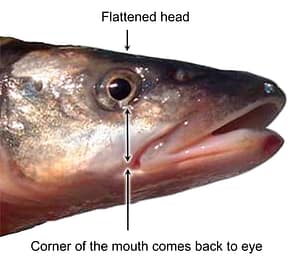Why Northern Pikeminnow?
Northern Pikeminnow eat millions of salmon and steelhead juveniles each year. The goal of the Derby is not to eliminate Northern Pikeminnow, a native species, but rather to reduce the number of large fish.
Reducing the number of these larger predators can greatly increase the salmon and steelhead juvenile populations.
What does a Northern pikeminnow look like?
This species has a head that is somewhat flattened between the eyes, a long snout and a large mouth. You can usually insert 2 to 3 fingers fully into an 11-inch Northern Pikeminnow’s mouth.


The Northern Pikeminnow is a large member of the minnow family. It has a deeply forked tail, and a long snout, and is commonly mistaken for peamouth.
Smallmouth Bass
Smallmouth bass (Bronzeback, Brown bass) are native to Eastern and Central North America, including the Great Lakes. They have been introduced into BC waterways as sport fish and are now found throughout the province.

Smallmouth Bass live in freshwater systems, including streams, lakes, rivers, and reservoirs. They prefer gravel with little aquatic vegetation and can be commonly found in sheltered areas under logs and docks.
Smallmouth bass are predators, and feed on smaller fish, amphibians, and aquatic insects. They have been known to deplete waterways of smaller fish and are considered a serious threat to native animals in the waterways they inhabit, including juvenile salmon. Smallmouth bass are designated as a Management Species by the BC Provincial Priority Invasive Species List.


To find out more about these two predator species, check out this link.
Here you can get lots more info on pikeminnow and smallmouth bass, as well as great fishing tips for catching them.
Not only that, get the low-down on any kind of fish you’re after, and learn lots more about them and how to catch them.
